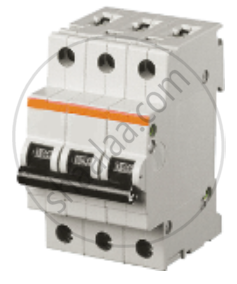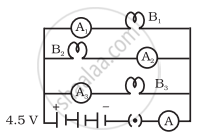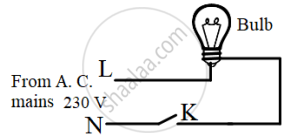Advertisements
Advertisements
प्रश्न
In the electric equipment producing heat like iron, electric heater, boiler, toaster etc., an alloy such as nichrome is used, not pure metals.
उत्तर
The performance and life of a heating element are determined by the material used to make the heating element. The heating element material must have a high melting point, high tensile strength, high resistivity, and a low-temperature coefficient of resistance. Because an alloy's resistivity is greater than that of pure metal, alloys are employed in electrical heating devices rather than pure metals. Furthermore, even at greater temperatures, the alloy does not easily burn (or oxidise).
APPEARS IN
संबंधित प्रश्न
An electric iron of resistance 20 Ω takes a current of 5 A. Calculate the heat developed in 30 s.
An electric heater of resistance 8 Ω draws 15 A from the service mains 2 hours. Calculate the rate at which heat is developed in the heater.
Why are the conductors of electric heating devices, such as bread-toasters and electric irons, made of an alloy rather than a pure metal?
How does the resistance of a wire vary with its area of cross-section?
Name any two effects of electric current.
Write Joule's law of heating.
An electric heater is connected to the 230 V mains supply. A current of 8 A flows through the heater.
(b) How much energy is transferred to the heater each second?
An electric iron of resistance 20 ohms draws a current of 5 amperes. Calculate the heat produced in 30 seconds.
Explain why, tungsten is used for making the filaments of electric bulbs.
A resistance of 25 Ω is connected to a 12 V battery. Calculate the heat energy in joules generated per minute.
The current passing through a room heater has been halved. What will happen to the heat produced by it?
The elements of electrical heating devices are usually made of:
(a) tungsten
(b) bronze
(c) nichrome
(d) argon
The heat produced in a wire of resistance 'x' when a current 'y' flows through it in time 'z' is given by:
(a) x2 × y × z
(b) x × z × y2
(c) y × z2 × x
(d) y × z × x
An electric iron is connected to the mains power supply of 220 V. When the electric iron is adjusted at 'minimum heating' it consumes a power of 360 W but at 'maximum heating' it takes a power of 840 W. Calculate the current and resistance in each case.
Identify the figure and give its use.

Statement 1 : Electric current ( flow of electrons ) creates heat in the resistor.
Statement 2 : Heat in the resistor is created according to the rule of energy conservation.
Explain Statement 1 with the help of Statement 2.
Why does tungsten metal used to make solenoid type coil in an electric bulb?
Give scientific reason :
In the electric equipment producing heat e.g. iron, electric heater, boiler, toaster, etc., an alloy such as Nichrome is used, not pure metals.
Answer the following question:
what is the heating effect of the electric current? state any four applications of it?
Answer the following question.
Write the mathematical expression for Joule's law of heating.
The electricity bill specifies the usage in _______.
These days when current in the circuit suddenly increases _______ switches are used.
A coil of an alloy _______ is used in electric heater cooker as a resistor.
What is the heating effect of electric current?
Write scientific reason.
A coil made up of alloy Nichrome is used in the electric heater cooker as a resistor.
How can overloading be avoided?
True or False – If False give the correct answer
The fuse wire does not melts whenever there is overload in the wiring.
An electric kettle consumes 1 kW of electric power when operated at 220 V. A fuse wire of what rating must be used for it?
Why is parallel arrangement used in domestic wiring?
B1, B2 and B3 are three identical bulbs connected as shown in Figure. When all the three bulbs glow, a current of 3A is recorded by the ammeter A.
- What happens to the glow of the other two bulbs when the bulb B1 gets fused?
- What happens to the reading of A1, A2, A3 and A when the bulb B2 gets fused?
- How much power is dissipated in the circuit when all the three bulbs glow together?

(a) Observe the diagram given below and state whether the bulb will glow or not when we switch on K.

(b) Is it safe to handle the bulb when the switch is OFF?
(c) Give a reason for your answer in (b).
Name the effect of the current responsible for the glow of the bulb in an electrical circuit.
What is a trip switch?
A trip switch is a ______ safety device.
Tara, after completing her exams, went to her grandmother's house along with her younger brother Rahul. One day, Rahul came home after playing and switched on the fan and air conditioner. At the same time, his grandmother was preparing a milkshake for him using a mixer. Suddenly, they heard a big sound and the electricity of the house got shut down. Tara is called an electrician. He said the main reason for supply to shut down was overloading.
- What is overloading?
- Is overloading and short the same? When does short-circuiting take place?
- How can the effects of overloading be avoided?
In which of the following applications of Iron, rusting will occur most? Support your answer with valid reason.
| A | B | C | D |
 |
 |
 |
 |
Write an expression for the amount of heat produced in a resistor when an electric current is passed through it stating the meanings of the symbols used.
